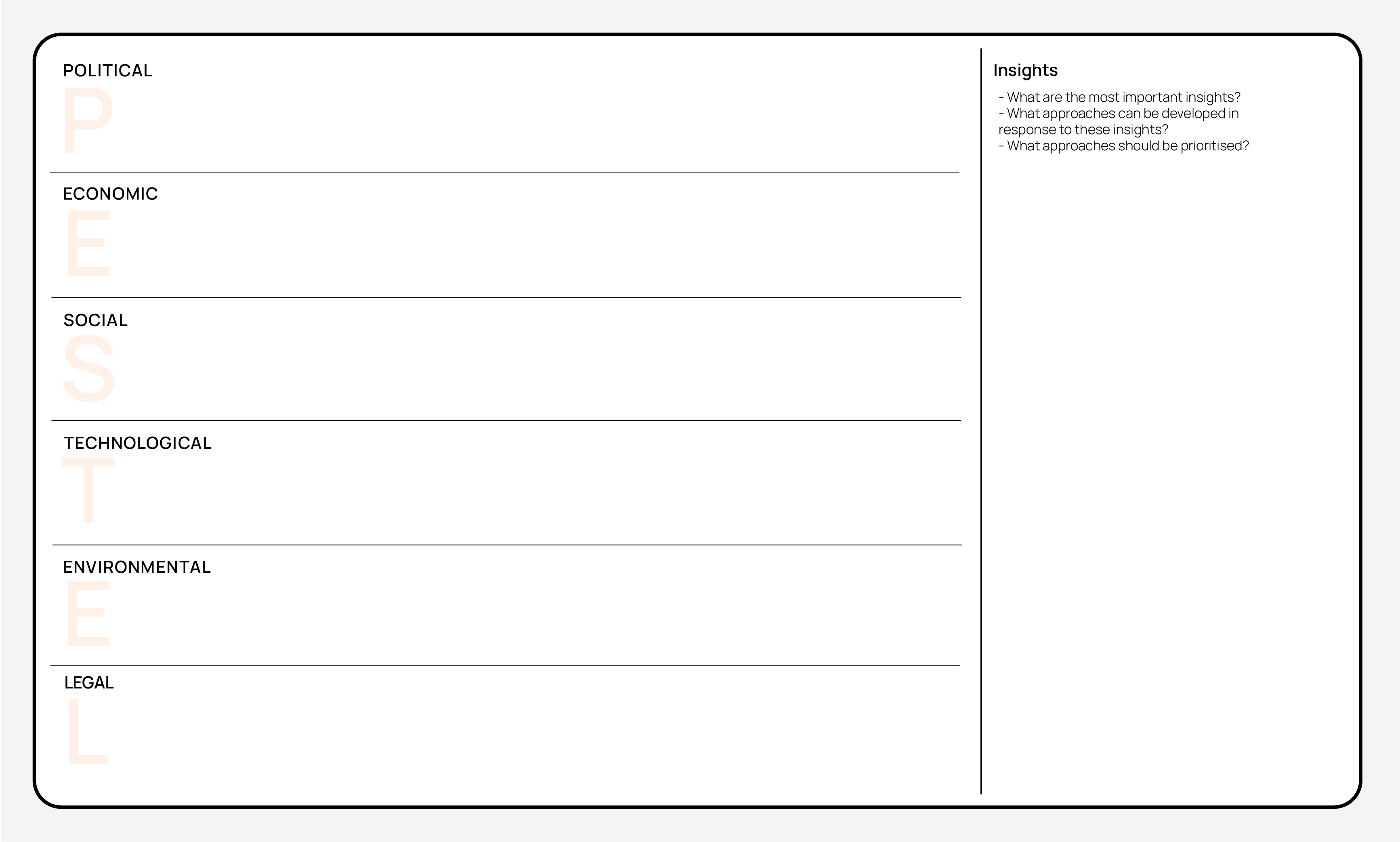PESTEL Analysis
PESTEL is a way to understand external influences that can impact an organisation or project.
PESTEL stands for:
P: Political – e.g. laws, regulations, government stability
E: Economic – e.g. economic growth, inflation, exchange rates
S: Social – e.g. cultural trends, demographics, lifestyle changes
T: Technological – e.g. technological advancements, innovation
E: Environmental – e.g. climate change, sustainability, environmental regulations
L: Legal – e.g. laws, regulations, compliance
The results
Identification of potential threats and opportunities

When to use it
Strategy Formulation: When undertaking strategy formulation
Decision-Making: When making decisions such as prioritising or scoping projects
Planning Behavioural Change: When planning projects that require people to change their actions or habits in society
Strengths
Comprehensive
Versatile across industries
Widely recognised
Identifies external opportunities and threats
Weaknesses
Limited consideration of relationships between influences
Can date quickly
Subjective
How to use it?
What do I need to start?
Choose the inputs which are most relevant to the situation, such as:
- P: Government reports and policy documents
- E: Economic reports and market research
- S: Studies on people, culture, and social trends
- T: Technology reviews and innovation reports
- E: Sustainability reports, environmental impact reports
- L: Regulatory documents, laws and compliance reports
How to use it?
Who to involve?
PESTEL can be done alone, or as part of a team. Consider including:
- People with industry insight into trending issues and opportunities
- Representatives with different perspectives who can analyse findings
- External advisors who can provide insights into key concerns
Step by step
1
Prepare
Create a plan for gathering information on each of the PESTEL categories. To help focus research, consider defining which PESTEL categories are most important, and drafting questions to help guide research. For example:
Political
- What political developments, such as elections, could impact this work?
- Are there upcoming policy changes or regulations that might affect the organisation?
- How stable is the current political environment?
Economic
- What economic trends could influence our market or industry?
- How do current interest rates or inflation levels impact our business?
- What’s the overall economic outlook, and how could it affect us?
Social
- What social or cultural trends are shaping customer preferences?
- How are demographic changes affecting our target market?
- Are there shifts in public opinion that could impact our strategy?
Technological
- What new technologies could disrupt our industry or offer opportunities?
- How is technology evolving in areas relevant to our business?
- Are there any emerging tech trends we should explore?
Environmental
- What environmental regulations might affect our operations?
- How are climate change and sustainability concerns influencing our industry?
- What environmental risks should we be aware of?
Legal
- What legal changes or regulations could impact our organisation?
- Are there any compliance requirements we need to consider?
- How might upcoming legal decisions affect our business?
2
Collect and analyse inputs
Collect relevant inputs for each category.
For each category, identify the most important trends, challenges, and opportunities.
3
Develop response
Use the analysis to inform a response and make key decisions. Ask questions like:
- What are the most important insights?
- How can we develop strategies in response to these insights?
- Which strategies should we prioritise for the greatest impact?
- Are there any risks or challenges associated with these strategies?
- What resources will be needed to implement these approaches?
- How will we measure the success of our chosen strategies?
- What timelines are realistic for implementing these strategies?
- How do these insights align with our overall organisational goals?